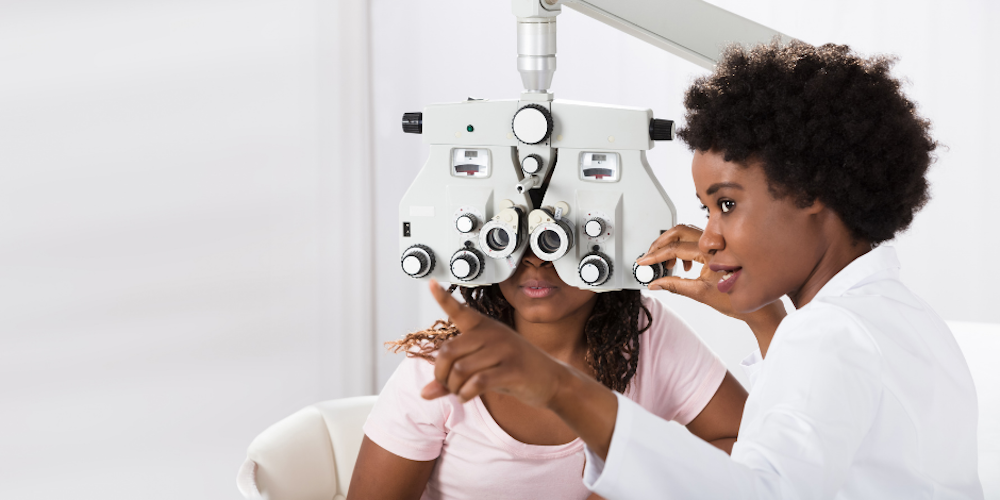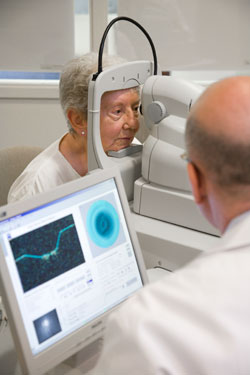Eye Care for Life

Eyesight is one of life’s most precious gifts. Our doctors and experienced staff at the Eye Clinic at Valley Medical Center are dedicated to helping you maintain and improve your eye health. From comprehensive exams and medical procedures, to specialized care for problems relating to a variety of health conditions, the Eye Clinic offers skill and expertise that will assist you and your family's eye health for life.
We provide medical and surgical eye procedures for cataracts, macular degeneration, glaucoma and vision-threatening diabetic retinopathy. When you have a preventive eye exam performed, we post your prescription to MyChart, so you always have it available when ordering frames or contact lenses.
The Continuum of Care
As with most routine healthcare, frequency of exams depends upon the patient’s age, health and family history.
At the Eye Clinic, we suggest the following routine of comprehensive eye exams:
- Before starting first grade
- Every year or two from age 6 to 18 for young people wearing glasses
- Every year or two from age 19 to 60
- Annually from age 61
- For diabetics, patients with vision problems or a family history of poor vision health, we recommend annual exams
NOTE: Simple exams for glasses or contacts prescriptions are NOT offered at this clinic.
 Should you need further attention, the Eye Clinic offers:
Should you need further attention, the Eye Clinic offers:
- Evaluation and treatment of glaucoma, macular degeneration, diabetic retinopathy, conjunctivitis, dry eye, eye injury, and other chronic conditions of the eye
- Cataract surgery
What is an Ophthalmologist?
An ophthalmologist is a highly skilled physician who is specially trained to provide your entire family with the full spectrum of eye care—including performing complex and delicate eye surgery. Many ophthalmologists are also involved in scientific research into the causes of, and cures for, eye diseases and vision problems.
Have Cataracts Impacted Your Vision?
A cataract is a clouding of the transparent lens in the eye. Over time, increased cloudiness can blur your vision and eventually rob you of the joy of reading, the ability to drive a car, and even something as simple as watching your favorite movie. Thanks to the latest surgical advances, clear vision can often be safely restored. If you suspect cataracts are impairing your vision, call 425.690.3415.
A Healthy Lifestyle Equals Healthy Eyes
 Smoking, hypertension, cholesterol, a bad diet and genetics can all contribute to your risk for eye disorders. High blood pressure, for example, compromises the body’s blood vessels, including those behind the retina. Unchecked, these risk factors can lead to a host of disorders. Macular degeneration, which can inhibit a person’s ability to read or drive, is the leading cause of vision loss or blindness in adults age 65 and older.
Smoking, hypertension, cholesterol, a bad diet and genetics can all contribute to your risk for eye disorders. High blood pressure, for example, compromises the body’s blood vessels, including those behind the retina. Unchecked, these risk factors can lead to a host of disorders. Macular degeneration, which can inhibit a person’s ability to read or drive, is the leading cause of vision loss or blindness in adults age 65 and older.
Eat a Healthy Diet
Eye-healthy foods include brightly colored fruits and vegetables containing antioxidants. Seeds, nuts, oily fish such as salmon and sardines and supplements including lutein, zeaxanthin, fish oil and alpha and beta carotenes provide nutrients for eye health.
Patient Perspective
“The doctor always took time to explain and listen. I felt very confident…as I had my cataract surgeries.”
Lorraine – cataract surgery patient
Other Ophthalmology Services
 Overview
Overview
Each year more than 60% of adults age 60 or older will show signs of cataracts, a clouding of the eye's natural lens. Symptoms may include poor reading vision, poor night vision, light seems more glaring than before, or colors appear less bright.
If you suffer from these symptoms, call our office for a simple screening exam.
Services Description
The Eye Clinic at Valley Medical Center has the most advanced technology available in its state-of-the-art facility. Our team is experienced and trained to perform the most technologically advanced medical and surgical eye procedures, including the removal of cataracts and the insertion of intraocular lenses. Cataract surgery is usually performed under local anesthesia on an outpatient basis and is one of the most successful procedures in all of medicine.
What is a Cataract?
A cataract is a clouding of the natural human lens. The lens is the part of your eye that focuses light onto the retina to produce clear images. It consists mainly of protein. If the protein in one's human lens denatures over time, it becomes cloudy and is called a "cataract."
One example of denaturing protein would be in "hard boiling" an egg. As the clear liquid (protein) of the egg is heated it denatures and becomes a white solid.
The human lens protein within the eye gradually denatures over years and first gets less flexible. By the age of 40 or so the lens is no longer able to flex to completely focus images for near, so we begin wearing reading glasses for close vision. At this age, however, the lens is usually still visually clear.
When Do Cataracts Occur?
Cataracts are a normal part of the aging process, the early signs of which may be noted as early as age 50. It has been said that if everyone lived to age 200 we all would need cataract removal. Some folks get cataracts earlier than others. Most cataracts progress slowly, and are not visually significant; until approximately age 65 or older. Cataracts can come on sooner with certain systemic diseases such as diabetes, or certain occupations, like glass blowers requiring one to stare at UV light all day at work.
When cataracts get more advanced they start to decrease the light's ability to pass efficiently through the lens, causing a decrease in visual clarity. They usually form slowly and are associated with no pain, redness, or tearing.
When Do I Worry About It?
A cataract is not significant, however, until it interferes with vision. If a cataract becomes large or dense, it usually can be removed by surgery, but some stay small and don't change one's eyesight much in the course of a lifetime.
While cataracts result in diminished acuity because of the opacification of the lens, they do not affect the field of vision, but these people have more difficulty seeing in poorly lit environments due to a decrease in contrast sensitivity. Many people with cataracts experience increased sensitivity to light and glare. Reading material appears faded or hazy and is more difficult to read in dim lighting. Patients sometimes also notice halos around streetlights or headlights at night. People frequently mention an overall sensitivity to glare, especially at night, such as the reflection of light from metal on a car or pavement, or fluorescent ceiling lights. Colors appear faded or washed out and a change in the patient's eyeglass prescription may not improve visual clarity. During the day, patients with cataracts may notice that they are morelight sensitive, but sunglasses only appear to reduce vision.
Cataract Surgery
Cataract surgery is generally very safe, has a high success rate, and is one of the most common surgeries performed in the U.S. It is estimated that 95% of patients experience improved vision after surgery, provided there are no other eye conditions or diseases present. Approximately 5% of surgery cases result in minor complications.
During a cataract surgery, the surgeon removes the cloudy natural lens of the eye and, in most cases, replaces it with a clear silicone or acrylic lens. This implant is actually a very small prescription lens placed inside the eye that will improve the quality of distance vision for most patients, although reading glasses are almost always still needed.
More Information
For more information on Cataract Removal, click here for our Patient Info page with informative links.
 You may see something floating or flashing within your vision, but what you may be seeing is matter that is floating in your eye. The condition, in most cases, is more bothersome than harmful. In some cases, the sudden appearance of floaters or flashes may indicate a more serious eye condition.
You may see something floating or flashing within your vision, but what you may be seeing is matter that is floating in your eye. The condition, in most cases, is more bothersome than harmful. In some cases, the sudden appearance of floaters or flashes may indicate a more serious eye condition.
Floaters (or ‘spots’) are tiny pieces of matter that are drifting inside your vitreous, the fluid that fills the inside of your eyes. Floaters are usually related to the normal aging process that can begin in your mid 40’s. They can appear to be small specks or strands of fiber that move slowly across your field of vision.
Flashes appear as streaks, shooting stars, or false blasts of light. Most adults after the age of 50 will experience flashes as part of the normal aging process when the vitreous thickens and rubs against the light-sensitive retina. As with floaters, flashes should be checked by an eyecare provider to ensure they are not the early sign of a more serious problem.
Dry Eye refers to a condition of the eye where either too few tears are produced, or tears drain too quickly from the eye. Symptoms may include eyes that feel itchy, gritty, red and dry; eyelids that stick together upon awakening; difficulty wearing contact lenses; hay fever or sinus problems, and recurring infections.
Common treatments of dry eye include simple eye drops known as “artificial tears” or the restriction or closing of the drainage passages in the eyelid. Left untreated, dry eye may lead to corneal infections and ulcers, conjunctivitis, chalazia and pterygia.
Dry eye can be caused by irregularities in the blinking process, medications, overexposure to natural elements, a Vitamin A deficiency, or an overly large drainage canal.
To determine if treatment is necessary, contact our office.
Glaucoma is the leading preventable cause of blindness. It is essential to catch this condition early and why adults 35 and older should visit an eye doctor every year.
In its early stages, glaucoma can only be detected through a test performed by your eyecare professional. The loss of vision is usually so gradual and painless that most people are unaware of it until damage is permanent. Vision lost through glaucoma cannot be restored.
Treatment includes eye drops and tablets to control fluid pressure within the eye, the cause of glaucoma. This pressure can lead to the pinching of the optic nerve, leading to the loss of peripheral vision and eventual blindness.
 Once again, this condition usually shows no symptoms in its early stages and can be detected during routine eye examinations. Macular degeneration occurs within the macula, located in the central area of the retina. This area is primarily responsible for your straight-ahead and color vision.
Once again, this condition usually shows no symptoms in its early stages and can be detected during routine eye examinations. Macular degeneration occurs within the macula, located in the central area of the retina. This area is primarily responsible for your straight-ahead and color vision.
As fluid separates the layers of the retina, vision cells in the macula are pushed out of their normal orientation. The result gives a person the feeling they are looking through flawed glass.
There is no known cure for the most common form of macular degeneration, although lasers can be used to repair weak areas of the macula. Low-vision aids, such as glasses, magnifiers, specially-designed lamps and large-print books and magazines help sufferers to lead a relatively normal life of vision.
For more information on eye and vision conditions, you may find some of these online resources helpful. If you have questions, please feel free to contact our office.
Cataracts
- National Eye Institute, National Institutes of Health (NEI/NIH)
- eMedicineHealth/Emergency Care, Consumer Health
- MedicineNet.com
- Vision In Focus


